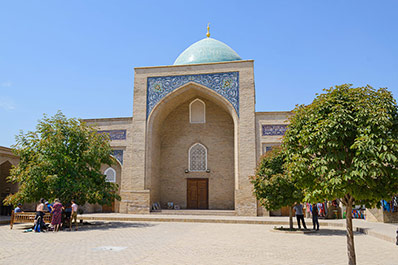Barrakh-Khan Madrassah, Tashkent

Barrakh-Khan medreseh is located to the east of Chorsu market, among the clay-walled buildings of the old city. In honour of the Khan, this Medreseh has developed as a religious-memorial complex. It underwent several stages of construction and was completed in 1532 (2nd half of the 16th c.).
The medreseh has a courtyard which is surrounded by one-story khudjras. The main facade is split by a portal with a half-octagonal niche, where the glazed tiles have been preserved. Medreseh construction represents a strongly extended trapezoid form from east to west built around an oblong courtyard. Inside are some late burials among which, incidentally, Barrack-khan is not present: data sources show that he died in 1556 and was buried in Samarkand. The mausoleum has a centrally located portal-dome, with four angular rooms and a cruciform hall.
On the right side of the portal is a board which states that here, inside the mausoleum, the residence of the Mufti of the Spiritual Board of Moslems of Uzbekistan is located. The complex is constructed from fragmentary brick. The decor of the facades has been used only on the main objects - the entrance peshtak of the medreseh, the portal and the dome of the mausoleum of Suyunidj-Khan.
According to historical data, dome of the mausoleum was covered with blue tiles; the drum of the dome was decorated with star girikh with a pattern of 8-pointed stars, made of mosaic. The decor of the entrance peshtak of the medreseh has now been restored. The timpan of the entrance arch is made from 6-sided majolica tiles, on which floral ornamentation has been painted. It creates a uniform composition. The complex of the medreseh has survived to the present, albeit with major damage and loss.



